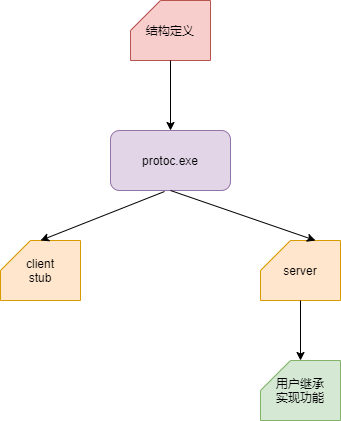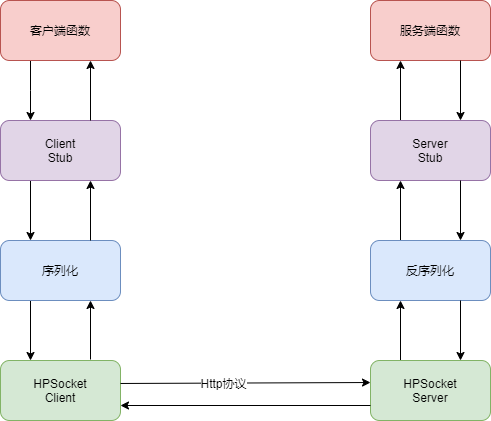简介
RPC是远程过程调用(Remote Procedure Call)的缩写形式 ,RPC的目的是为了简化网络通信,让用户可以专注于业务处理,不用关心网络层的处理,真正实现在客户端A中调用函数F就可以调用服务端B中的函数F的目的。
RPC 模型引入存根进程( stub) 的概念, 对于服务端的服务类A,在客户端通过A::stub类进行调用,中间的网络交互流程有RPC框架进行实现。
实现
我们可以借助protobuf来实现序列化和stub的生成,借助HpSocket来完成网络的交互,为了简单,我们采用HTTP协议来进行消息的交互。
protobuf生成stub

RPC交互流程

实现流程
第一步、定义protobuf结构
syntax = "proto3";
//支持rpc服务代码生成
option cc_generic_services = true;
//C#命名空间
option csharp_namespace = "Google.Protobuf.Auth";
package Auth;
//Rpc协议
message RpcProtocol
{
uint32 serviceId = 1;
uint32 methodId = 2;
bytes data = 3;
int32 falg = 4;
}
message UserInfo
{
string phoneNum = 1;
string password = 2;
}
message ResponseMsg
{
int32 code = 1;
bytes message = 2;
}
//鉴权服务
service Authentication {
//注册申请
rpc UserApplyReg(UserInfo) returns (ResponseMsg);
//用户注册
rpc UserRegister(UserInfo) returns (ResponseMsg);
//用户登陆
rpc UserLogin(UserInfo) returns (ResponseMsg);
}
第二步、服务端实现
#include <stdio.h>
#include "WebService.h"
#include "Authentication.h"
//Rcp 服务端演示
int main()
{
//启动web接口线程
WebService *pSrvProc = new WebService();
pSrvProc->RegisterService(new CAuthentication);
CHttpServerPtr pHttpSrv(pSrvProc);
if (pHttpSrv->Start("0.0.0.0", 9090))
{
printf("创建web server 成功");
}
else
{
printf("创建web server 失败");
}
while (true)
{
Sleep(10000);
}
}
第三步、客户端实现
#include <iostream>
#include "RpcChannel.h"
#include "RpcController.h"
#include "proto\Authentication.pb.h"
//Rcp 客户端演示
int main()
{
std::string strSrvAddr = "http://127.0.0.1:9090";
CRpcChannel channel(strSrvAddr);
CRpcController pController;
Auth::Authentication::Stub stub(&channel);
Auth::UserInfo req;
Auth::ResponseMsg res;
req.set_phonenum("10086");
stub.UserApplyReg(&pController, &req, &res, NULL);
std::cout << res.message() << std::endl;
req.set_password("********");
stub.UserRegister(&pController, &req, &res, NULL);
std::cout << res.message() << std::endl;
stub.UserLogin(&pController, &req, &res, NULL);
std::cout << res.message() << std::endl;
}
核心代码
一、CRpcChannel 的实现,用于封装客户端与服务端交互流程
#include "RpcChannel.h"
#include "proto\Authentication.pb.h"
#include <google\protobuf\message_lite.h>
#include <google\protobuf\message.h>
#define PROTOBUF_PROTOCOL_FLAG 0xfafbfcfd
CRpcChannel::CRpcChannel(const std::string& srvAddr):m_strSrvAddr(srvAddr)
{
}
CRpcChannel::~CRpcChannel()
{
}
void CRpcChannel::CallMethod(const proto::MethodDescriptor* method,
proto::RpcController* controller,
const proto::Message* request,
proto::Message* response,
proto::Closure* done)
{
Auth::RpcProtocol message;
message.set_serviceid(method->service()->index());
message.set_methodid(method->index());
message.set_falg(PROTOBUF_PROTOCOL_FLAG);
message.set_data(request->SerializeAsString());
CHttpSyncClientPtr httpReq(nullptr);
std::string strBody = message.SerializeAsString();
int nSize = strBody.size();
std::string strBodySize = std::to_string(nSize);
THeader header[] = { { "Content-Type", "text/plain;charset=utf-8" },{ "Content-Length", strBodySize.c_str() } };
int iHeaderCount = sizeof(header) / sizeof(THeader);
if (!httpReq->OpenUrl("GET", m_strSrvAddr.c_str(), header, iHeaderCount, (const BYTE*)strBody.c_str(), strBody.size()))
{
printf("发送结果失败");
return;
}
BYTE * respBody = nullptr;
int len = 0;
if (httpReq->GetResponseBody((LPCBYTE*)&respBody, &len) == FALSE)
return;
response->ParseFromString((char*)respBody);
}
二、服务器处理
EnHttpParseResult WebService::OnMessageComplete(IHttpServer * pSender, CONNID dwConnID)
{
char* pszBuf = nullptr;
pSender->GetConnectionExtra(dwConnID, (VOID**)&pszBuf);
char szBuf[64] = { 0 };
int nSize = sizeof(szBuf);
USHORT nPort;
pSender->GetRemoteAddress(dwConnID, szBuf, nSize, nPort);
Auth::RpcProtocol protoMsg;
if (!protoMsg.ParseFromString(pszBuf))
{
std::cout << "无效消息" << std::endl;
return HPR_ERROR;
}
if (m_mapService.find(protoMsg.serviceid()) != m_mapService.end())
{
auto pRpcMonitor = m_mapService[protoMsg.serviceid()];
const protoBuf::ServiceDescriptor *service_descriptor = pRpcMonitor->GetDescriptor();
const protoBuf::MethodDescriptor *method_descriptor = service_descriptor->method(protoMsg.methodid());
const protoBuf::Message& request_proto = pRpcMonitor->GetRequestPrototype(method_descriptor);
const protoBuf::Message& response_proto = pRpcMonitor->GetResponsePrototype(method_descriptor);
protoBuf::Message *reqMsg = request_proto.New();
reqMsg->ParseFromString(protoMsg.data());
protoBuf::Message *resMsg = response_proto.New();
CRpcController pController(szBuf);
pRpcMonitor->CallMethod(method_descriptor, &pController, reqMsg, resMsg, NULL);
std::string strBody = resMsg->SerializeAsString();
int nSize = strBody.size();
std::string strBodySize = std::to_string(nSize);
THeader header[] = { { "Content-Type", "text/plain;charset=utf-8" },{ "Content-Length", strBodySize.c_str() } };
int iHeaderCount = sizeof(header) / sizeof(THeader);
pSender->SendResponse(dwConnID,
HSC_OK,
"Http Server OK",
header, iHeaderCount,
(const BYTE*)strBody.c_str(),
strBody.size());
}
return HPR_OK;
}
三、服务端业务实现
#include "Authentication.h"
void CAuthentication::UserApplyReg(::google::protobuf::RpcController * controller, const::Auth::UserInfo * request, ::Auth::ResponseMsg * response, ::google::protobuf::Closure * done)
{
std::cout << "用户:" << request->phonenum() << "申请" << std::endl;
response->set_code(0);
response->set_message("允许申请");
}
void CAuthentication::UserRegister(::google::protobuf::RpcController * controller, const::Auth::UserInfo * request, ::Auth::ResponseMsg * response, ::google::protobuf::Closure * done)
{
std::cout << "用户:" << request->phonenum() << ", 密码 " << request->password() << "正在注册" << std::endl;
response->set_code(0);
response->set_message("注册成功");
}
void CAuthentication::UserLogin(::google::protobuf::RpcController * controller, const::Auth::UserInfo * request, ::Auth::ResponseMsg * response, ::google::protobuf::Closure * done)
{
std::cout << "用户:" << request->phonenum() << ", 密码 " << request->password() << "正在登陆" << std::endl;
response->set_code(0);
response->set_message("登陆成功");
}
至此一个简单的RPC交互流程就完成了













